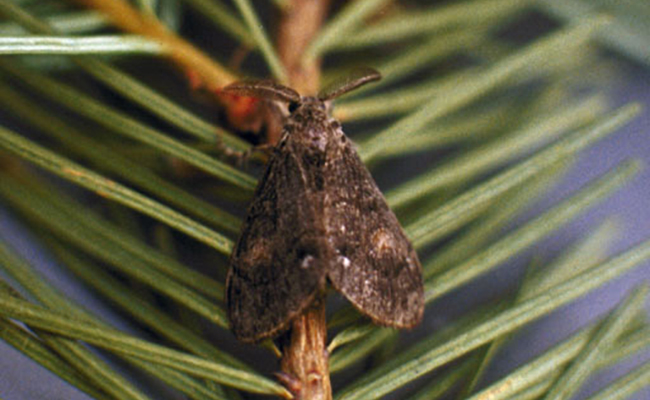FVS Models & Event Monitor Files
Douglas-fir Tussock Moth Model
The Douglas-fir Tussock Moth Model simulates Orgyia pseudotsugata (McDunnough), Lepidoptera: Lymantriidae.
Insect Description
Douglas-fir Tussock Moth, Orgyia pseudotsugata (483 KB PDF)
Model Description
The Douglas-fir Tussock Moth (DFTM) model, an extension to the Forest Vegetation Simulator (FVS), simulates the affects of DFTM, Orgyia pseudotsugata, which is a defoliator of true firs and inland Douglas-fir. The model maintains representation of two tree species: Douglas-fir and white fir (or grand fir: white fir and grand fir species share the same parameters and reference indices in the model).
The original model source code was developed almost exclusively by Nicholas L. Crookston and James J. Colbert from 1978 to 1981, after which Robert A. Monserud and Nicholas L. Crookston co-authored "A User's Guide to the Combined Prognosis and Douglas-fir Tussock Moth Outbreak Model" (US Forest Service, General Technical Report INT-127, 1982). Except for code modifications necessary to maintain consistency with FVS and meet requirements of compilers and platforms, the model has not been altered from its original specifications.
The DFTM model simulates the reduced growth and increased mortality of host tree species due to defoliation by the tussock moth larvae. The model functions on a tree-class system and not on individual trees records. The default number of tree classes on which the model operates is 20, but the user may change that number. Outbreaks are scheduled in one of two methods: through random scheduling or by specific dates. Other initialization parameters set larvae populations and host foliage biomass. The user may provide the initial number and allocation of first instar larvae as well as specify the method of foliage biomass calculation and parameters for Douglas-fir and grand (true) fir foliage biomass weights. The options of pest control available to the user include chemical or virus application at various points during the outbreak. The DFTM model does respond to prescribed FVS management actions such as thinning and also offers its own salvage routine to remove all surviving host trees at a specific minimum of defoliation at the end of an outbreak.
Documentation
Rocky Mountain Forest and Range Experiment Station
Gtr-INT-127
September 1982
Douglas-fir Tussock Moth Model User's Guide (3.3 MB PDF)
Keyword Guide
Douglas-fir Tussock Moth Model Keyword Guide (60 KB PDF)
Download

Douglas-fir tussock moth. Photo by David McComb, USDA Forest Service, www.forestryimages.org

